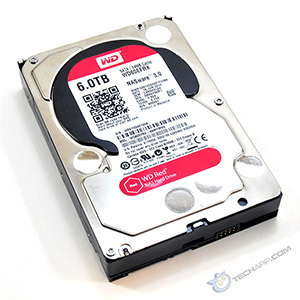Conclusion
 |
When Western Digital first launched their Red family of NAS hard disk drives, it was seen as an improved WD Green drive that runs cooler and quieter, with a special firmware that Western Digital calls NASware. It quickly replaced WD Green drives then populating NAS systems. But it was not good enough (at that time) for larger NAS systems, where 8 or more hard disk drives spinning together would generate far more vibration than regular Red drives can handle.
Enter the new Western Digital Red Pro family of NAS drives, designed specifically to tackle the challenge of ensuring reliable performance in a large NAS system. To top it off, Western Digital gave the Red Pro a speed boost with a spindle speed of 7200 RPM. In other words, the Red Pro is the NAS version of the Western Digital Black drive. However, there was a "problem" with the Red Pro drives - they were more expensive than the "regular" Red drives.
Fortunately, Western Digital has further improved their NASware firmware, allowing their newer Red drives to support up to 8 drives in a single NAS enclosure! What this means is you don't have to get the more expensive Red Pro drives unless you need the higher spindle speed, or need to use more than 8 drives in a single enclosure.
Of course, this is only true for the newer Western Digital Red drives with the new NASware 3.0 firmware. Since there is no NASware upgrade for the older Western Digital Red drives, you will have to purchase a new drive to enjoy the advantages of NASware 3.0. If you are in the market for a new NAS drive, might as well consider the highest capacity drive you can buy, and for now, that would be the 6 TB Western Digital Red (WD60EFRX).
Although the 6 TB Western Digital Red may seem to be merely a higher-capacity version of the 4 TB Western Digital Red, it is quite different internally. Not only does it sport the new 1.2 TB platters, it also comes with a new Marvell 88i1047 processor and a new Western Digital PIKE drive motor controller. Nothing is known about the Marvell processor but based on our test results, it seems to be much faster than the Marvell 88i9446 processor used in the 4 TB model.
The 6 TB Western Digital Red is a 5400 RPM drive, but its higher-density platters allowed it to match and even beat 7200 RPM hard disk drives in pure thoroughput, especially in the outer tracks. However, it also ran as hot as the 7200 RPM drives. Heat is a problem for NAS drives since many of these drives will be enclosed within the tight confines of a NAS enclosure, and their combined heat could kill the drives.
![]() Western Digital obviously knew this could be a big problem, so they uprated the Red drives' maximum ambient temperature limit from 60°C to 65°C. They were also more aggressive with its power consumption when it idles, which noticeably reduces its thermal output. Since NAS systems idle their drives more aggressively than desktop systems, this should result in a lower thermal output in the real world than was apparent in our stress tests. Of course, you will also need to use fewer drives if they are all 6 TB drives...
Western Digital obviously knew this could be a big problem, so they uprated the Red drives' maximum ambient temperature limit from 60°C to 65°C. They were also more aggressive with its power consumption when it idles, which noticeably reduces its thermal output. Since NAS systems idle their drives more aggressively than desktop systems, this should result in a lower thermal output in the real world than was apparent in our stress tests. Of course, you will also need to use fewer drives if they are all 6 TB drives...
That is really the 6 TB Western Digital Red's main attraction - its enormous storage capacity.
NAS systems do not need speedy drives. They are, after all, limited by the network connectivity, so there's no real need for very fast drives. What most people need is the largest capacity drive that they can afford so they don't need to buy a larger NAS. Fewer drives also mean lower power consumption and lower thermal output. If you are a home user, or a SMB using a small NAS, the smart money's on loading up your NAS with the 6 TB Western Digital Red (WD60EFRX) instead of getting a larger NAS and using smaller capacity drives.
For the lowest current prices on Western Digital Red hard disk drives, click here!
Support Tech ARP!
If you like our work, you can help support out work by visiting our sponsors, participate in the Tech ARP Forums, or even donate to our fund. Any help you can render is greatly appreciated!
Page |
6 TB Western Digital Red Review |
|
1 |
||
2 |
||
3 |
||
4 |
• WD Red Hardware Enhancements |
|
5 |
• Testing The 6 TB Western Digital Red |
|
6 |
• Transfer Rate Range, Platter Profile |
|
7 |
||
8 |
||
9 |
||
10 |
Support us by buying from Amazon.com! |
|
| Grab a FREE 30-day trial of Amazon Prime for free shipping, instant access to 40,000 movies and TV episodes and the Kindle Owners' Lending Library! | |
Questions & Comments
Please feel free to post your questions or comments here!
| Date | Revision | Revision History |
11-12-2014 |
1.0 |
Comprehensive review release. |
05-01-2015 |
2.0 |
Added a page on the WD Red's hardware enhancements, NASware 3.0 and TLER support. |







 Add to Reddit
Add to Reddit
